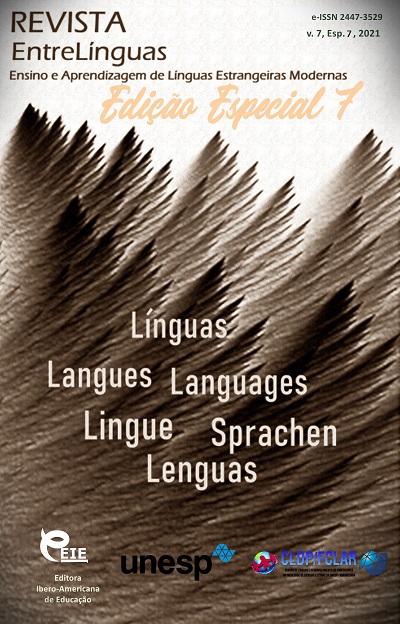Cognitive text attractors as means of creating a text world (based on the novel by T. Kennelly the daughters of mars)
DOI:
https://doi.org/10.29051/el.v7iesp.7.16276Keywords:
Text world, Text cognitive attractors, Literary text, Concept sphere, NominationAbstract
The theory of text worlds is one of the most prominent and rapidly developing research fields in modern cognitive linguistics. Nowadays nearly all newly postulated theories dealing with the literary text, literary concepts or concept sphere of a literary text try to deploy their ideas along with the text worlds theory. The theory of text attractors is not an exception. The study examines the concept of cognitive text attractors within the framework of the theory of text worlds, emphasizing the importance of the roles of the reader and the recipient in the process of creating a text world. The idea of different perceptions of various text attractors by readers and recipients in the process of creating a text world is expressed. The author analyses the existing classification of text cognitive attractors and broadens it with new types of text cognitive attractors identified in literary text under study: the text olfactory cognitive attractors and the text thematic cognitive attractors. With the help of contexts from a literary text, it is substantiated that, being subjected to the genre features of a literary text constructing, any type of cognitive text attractor can be thematically conditioned.
Downloads
References
BRANACH-KALLAS A. Misfits of War: First World War Nurses in the Daughters of Mars by Thomas Keneally. Studia Anglica Posnaniensia, 52 (4), 409-426. 2017.
EREMENKO, I. A. To the question of “literary concept” notion status. Scientific notes of Tavricheskyi national university of V. I. Vernadskyi. [Uchenye zapiski Tavricheskogo natsional'nogo universiteta im. V. I. Vernadskogo], 19(3), 120-124. [in Russian]. 2006.
KENEALLY, T. The Daughters of Mars: A Novel. / Vintage, Australia. 2012. URL: https://www.rulit.me/books/the-daughters-of-mars-download-308336.html
KUSHNERUK, S. L. Text world theory as a research program within cognitive linguistics. The issues on cognitive linguistics. [Voprosi kognitivnoi lingvistiki], 1, 45-51. 2011. [in Russian]
OGNEVA, E.A. Text cognitive attractors concept. Lingustics horizons. [Lingvisticheskie gorizonty] Issue VI. pp. 87-92. 2018. [in Russian]
POPOVA T. G. Literary picture of the world as conceptualized literary space. Language and culture within the epoch of globalization. [Yazyk i kul'tura v epokhu globalizatsii], 2 (1), 95-97. 2013. [in Russian]
SEMINO, E. Language and World Creation in Poems and Other Texts. E. Semino. Longman: L. and N. Y. 267 p. 1997.
SERGEEVA E. V. To the question of concepts classification within a literary text. Tomsk state pedagogical university herald. [Vestnik Tomskogo gosudarstvennogo pedagogicheskogo universiteta] №. 5. pp. 98-102. 2006. [in Russian]
SHMID, V. Narrotology. Languages of Slavic culture. [Yazyki slavyanskoy kul'tury] 2003. 312p. 2003. [in Russian]
WERTH, P. Text Worlds: Representing Conceptual Space in Discourse. L.: Longman. 1999.
Downloads
Published
How to Cite
Issue
Section
License

This work is licensed under a Creative Commons Attribution-NonCommercial-ShareAlike 4.0 International License.
Os manuscritos aceitos e publicados são de propriedade da Revista EntreLínguas. Os artigos publicados e as referências citadas na Revista EntreLínguas são de inteira responsabilidade de seus autores.
Transferência de direitos autorais – autorização para publicação
Caso o artigo submetido seja aprovado para publicação, já fica acordado que o(s) autor(es) autoriza(m) a UNESP a reproduzi-lo e publicá-lo na EntreLínguas, entendendo-se os termos “reprodução” e “publicação” conforme definição respectivamente dos incisos VI e I do artigo 5° da Lei 9610/98. O artigo poderá ser acessado pela rede mundial de computadores (Internet), sendo permitidas, a título gratuito, a consulta e a reprodução de exemplar do artigo para uso próprio de quem a consulta, desde que haja a citação ao texto consultado. Essa autorização de publicação 328 EntreLínguas, Araraquara, v. 1, n .2, p. 323-328, jul./dez. 2015 não tem limitação de tempo, ficando a UNESP responsável pela manutenção da identificação do(s) autor(es) do artigo. Os artigos publicados e as referências citadas na Revista EntreLínguas são de inteira responsabilidade de seus autores.











